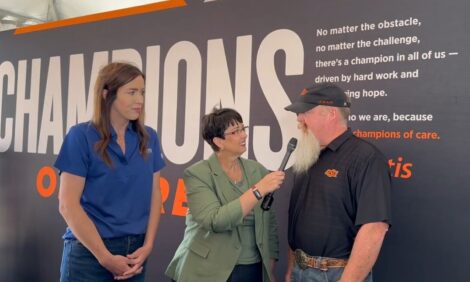



PRRS vaccine PROGRESSIS aids Acclimatisation of Gilts
At a farm "GAEC des Pins" in the Finistere region of France, a combination of an increase in the number of sows and an outbreak of PRRS resulted in serious problems with the acclimatisation of incoming gilts. To address the situation, technical advisors from COFIPORC Livestock, Pluguffan, France decided that controlling the PRRS outbreak was the main priority. Merial's new inactivated PRRS vaccine, PROGRESSIS, was used to control the outbreak in combination with changes to reproduction management.
|
André PEILLET "Problems with incoming gilts started when we increased the number of breeding females from 120 to 160, which made us introduce 18 gilts at a time. Half of them became severely ill and this happened each time we introduced new gilts ". |

|
Philippe HAMON underlines : "We tried to control the incoming gilt disease problems in the boar-section without considering that PRRS was a particular concern. Unsuccessful treatment attempts and the follow-up examination of the herd's serological status over time made us realize vaccination was needed." |

|
Philippe Hamon: "We tried to control incoming gilts' disease problems in the boar-section without considering that PRRS was involved. Unsuccessful treatment attempts and examination of the herd's serological status over time made us realize vaccination was needed. From now on, Andre Peillet will be using PROGRESSIS. |
The PRRS outbreak started at the end of 1999 when the number of breeding females was increased from 120 to 160. The incoming gilts were placed in the boar section for acclimatisation, however half of the gilts introduced to the farm became severely ill within ten days. However, at this stage PRRS was not considered to be part of the equation.
Andre PEILLET recalls "There were no deaths but the gilts showed decreased appetite, fever (102-106 °F) and respiratory distress. This happened every 6 weeks as the new gilts were coming in. This forced me to postpone oestrus synchronization, and many gilts returned to oestrus after the first AI".
As a result the Weaning to Service Interval (WFI) rose to 20 days in year 2000. Dr Phillipe Hamon explained however, that the other reproduction parameters did not change during this period.
Many unsuccessful treatment attempts
Prior to PRRS being identified as the problem (and the subsequent introduction of the PROGRESSIS vaccination program), a symptomatic treatment had been used to halt the 'disease' in the newly introduced gilts. This consisted of aspirin and vitamin C and if necessary an antibiotic treatment during the first week spent in the boar-section. "We even treated a group of old sows in the boar-section with antibiotics, without any significant result".
Andre PEILLET added: "Multiparous sows exhibited no clinical signs. Some were depressed and constipated, but none had fever or reproductive problems. We also introduced gilts from hardier stock, but of the same breed. We also increased quarantine infection."
However, the problems did not go away. Philippe Hamon summed up "Based on the clinical signs we had not immediately focused on PRRS despite the fact that the herd was infected while the purebred supplying unit was not. However we decided to look at the PRRS serological status of the breeding animals. In January 1999 only 17% of sows were positive while in September 2000, after the number of breeding animals increased, 63% of sows and 10% of pigs were positive". The virus spreading in the boar-section and among finishing pigs resulted in a serological conversion of all the sows within a month.
Setting up PROGRESSIS vaccination.
On January 15th 2001 all the breeding females and gilts that were in quarantine were vaccinated providing us with nearly a year's worth of data." For more than a year prior to vaccination, all the gilts that had come in were ill. The first disease-free group was the first one vaccinated with PROGRESSIS".
In Philippe Hamon and Andre Peillet's opinion this was no coincidence and justifies adding PROGRESSIS vaccination to the quarantine disease control program. (see text box below).
Meanwhile, the herd's AI management was revised. Andre Peillet said "Once more, Cofiporc technical support has been really helpful, Loïc ABIVEN came several times to help me change my AI management".
Back to normal sanitary conditions
Dr Philippe Hamon reiterated " The Herd's Technical Parameters (HTP) haven't changed much but that was not our main goal. The main problem to be solved was gilts acclimatisation and this is alright now : WFI is back to 6 days and HTP should improve as well " (see table below)
In summary, it is thanks to PROGRESSIS that the proper acclimitisation of incoming gilts became possible despite an intense outbreak of PRRS on the unit.
Table 1: |
||
| Before PROGRESSIS vaccination period | During PROGRESSIS vaccination period | |
| HTP from 01/02/2000 to 31/12/2000 | HTP from 01/07/2001 to 30/09/2001 | |
| WFI 2nd litter | 28 days | 9.5 days |
| WFI 3rd litter | 22 days | 5 days |
| Total born | 13.85 | 13.93 |
| Liveborn / litter | 12.48 | 12.67 |
| Last weaning to culling interval | 51 days | 37 days |
Quarantine : |
Further Information
For further information on PRRS BROWSE or SEARCH our Pig Health Database.Alternatively look up PRRS in our Quick Disease Guide
The following feature articles are also available on these topics:
Closed Herd Plan Helps Fight off PRRS
Embryo Transfer Preserves Genetics, Sidesteps PRRS
Reproductive Failures Not All PRRS
Usage instructions & withdrawal periods may vary by Country.
Always follow label instructions.
NOTE: Reference to commercial products or trade names within information provided by thePigSite.com does not constitute an endorsement by the thePigSite.com and does not imply discrimination against any other similar products.







